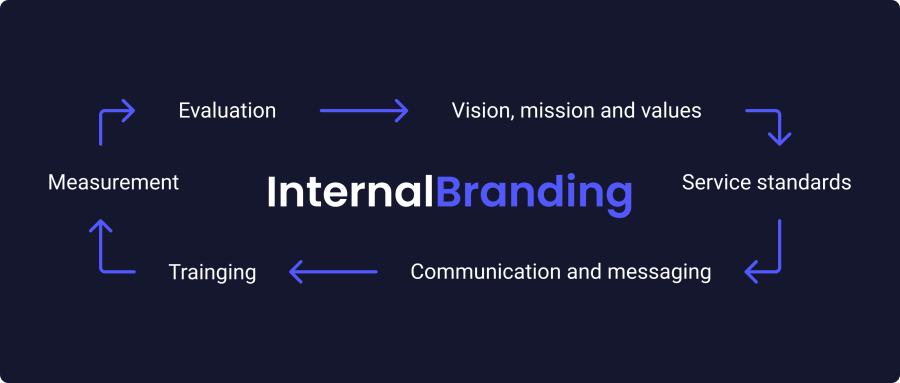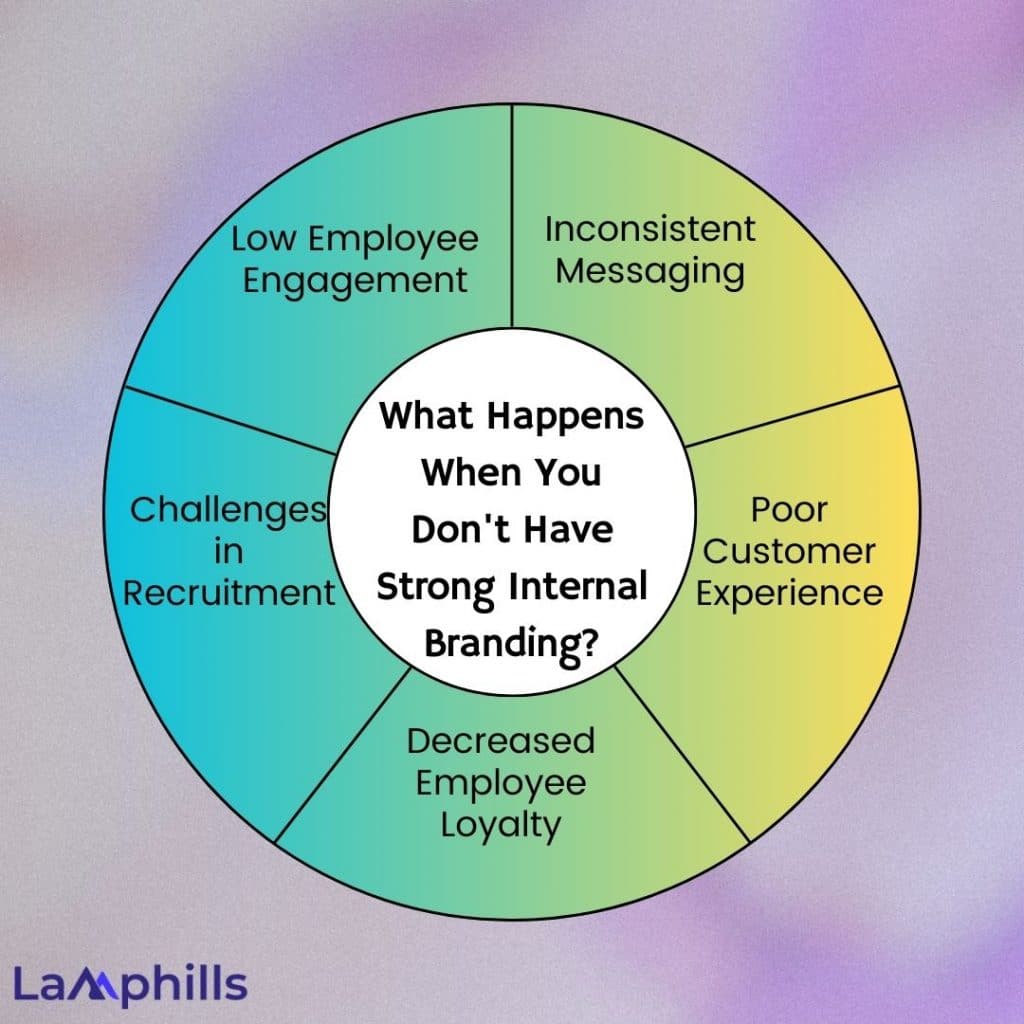When you think of a brand, you usually think of what your company portrays to customers, prospects, and consumers and how your company is overall identified. Yet your employees are also the core of your brand, which is why the term “internal brand” is used.
Most people think communicating with your employees through memos, bulletin boards, or company newsletters is enough to create a positive internal brand. Today, it should be no secret that it is not.
To help you get started on your internal branding journey, continue reading!
Key Points
- Internal branding is the ongoing process of educating employees so they understand, support, live, advocate, and guard your brand promise.
- Internal branding helps employees better understand the company’s mission and develop an emotional connection to the company.
- When you don’t have strong internal branding, your company is prone to low employee engagement, inconsistent messaging, poor customer experience, decreased employee loyalty, and challenges in recruitment.
- Companies with strong internal branding include T-Mobile, Drift, and Adobe.
What Is Internal Branding?

Internal branding is the ongoing process of educating employees so they understand, support, live, advocate, and guard your brand promise. This helps your employees understand why they’re doing their jobs for the company and how they’re fitting into a long-term vision.
You might think this all sounds great, but does internal branding work? It does. A classic Harvard Business Review article explores how effective internal branding can be and points to a study done when British Petroleum rebranded to BP and launched an internal branding campaign. The results were compelling:
- 76% of employees felt good about the new brand.
- 80% knew the brand values aligned with the new brand messages.
- 90% of employees felt the company was going in the right direction.
Internal branding helps employees better understand the company’s mission and develop an emotional connection to the company.
Even better, a strong internal branding strategy also helps with external branding. When your employees represent your company—whether on the phone with customers, participating in industry events, or casually discussing their jobs with friends—they will align with your overall brand.
Check out our branding strategy template below:
What Are the Objectives (Importance) of Internal Branding?
Internal branding emphasizes employees respecting the brand’s values, history, and objectives by representing themselves. Brands believe and understand that success depends on people.
An employee is a game-changer for brands. When they understand and believe in the brand’s values, they glorify the company’s good days and vice versa. The whole idea of internal branding lies in the outcome of a positive reputation and building credibility.
When employees believe in the brand, they behave like brand advocates by sharing brand content on social media and making effective business referrals.
As per a Nielsen report-
“Around 84% of people trust recommendations from colleagues, friends, and family over other marketing methods.”
Another study by MSLGroup suggests that-
“Brand messages reached 561% more when employees shared them than those shared by official brand social channels.”
Hence, effective internal brand-building strategies are crucial for optimizing brand presence. As a brand CEO, simply trying to develop internal branding is the bare minimum. Instead, one should look forward to creating an internal branding that is unique to them.
Take an example from what happens around in most companies. You’ll learn how memos, newsletters, or bulletin boards are commonly used with nothing in between. Well, you should know that the three are not enough!
Brands are built only after rigorous hard work, effort, and investments. A little more investment in internal branding is not going to hurt. Because it will follow up on employees’ behavior, it will be worth every penny you pay. And when everything seems to be going in the proper direction, the brand will witness better sales rates.
What Happens When You Don’t Have Strong Internal Branding?

After you have gone through the objectives and importance of internal branding above and you wish not to invest in it, below are possible things that will happen:
- Low Employee Engagement: Employees may feel disconnected from the company’s mission and values without a clear and compelling brand message. This can lead to lower motivation, reduced productivity, and higher turnover rates.
- Inconsistent Messaging: If employees are not aligned with the brand, the messages they convey to customers and other stakeholders can be inconsistent, leading to confusion and a weakened brand perception.
- Poor Customer Experience: Employees who are disengaged or do not understand the brand are less likely to deliver the service and experience that aligns with the company’s promises, negatively affecting customer satisfaction and loyalty.
- Decreased Employee Loyalty: Strong internal branding fosters employees’ sense of belonging and pride. Without it, employees may feel less loyal to the company, increasing the risk of attrition.
- Challenges in Recruitment: Companies with weak internal branding may struggle to attract top talent, as prospective employees may not see the company as an attractive workplace.
What Is the Difference Between Internal and External Branding?
External branding refers to how the public perceives the brand. The idea behind external branding can be conveyed through company logos, colours, print designs, leaflets, and other promotional materials.
As opposed to external branding, internal branding (in a way) takes on a life of its own and stays within the company. Employees who are well educated on the company, its goals, and values share the brand’s unique vision and deliver impeccable service outside the boundaries of the business. This is where internal and external branding intersect.
Strategies for Building an Internal Brand at Your Company
So, how do you build and embed an internal brand that will transform employees into true brand ambassadors who contribute to your business’s success?
These eleven steps will show you how:
#1. Define Your Values and Mission
Without a defined direction, your business will lack an identity or purpose with which your employees can identify. Defining your organization’s mission, vision, values, and culture and emphasizing those philosophies or principles that make you “YOU” will communicate exactly what is important to your employees. Companies whose employees have a higher sense of purpose outperform others by as much as 400%.
Having a strong mission and values gives your employees a sense of purpose in their roles, increasing job satisfaction and promoting engagement—which has a proven link to business outcomes.
An internal branding win
When it launched a ‘ Purpose Program, ‘ professional services giant KPMG taught us all a lesson in internal branding,’ asking employees to respond to the prompt “What my job means to me.”
As a result, the company was overwhelmed by an astounding 42,000 entries via its employee intranet, with staff creating posters that included personal testimonials relaying the meaning they derived from their jobs. From “I advance science” to “I help farms grow,” the responses demonstrated the company values and purposes that resonated with employees. After this initiative, the company had the most profitable year in its 118-year history.
#2. Set Your Core Values
If your mission statement is your company’s “why,” your core values are the “how.” Core values are the principles that drive your work and define your company culture.
For example, here are Patagonia’s core values:
- Build the best product
- Cause no unnecessary harm
- Use business to protect nature
- Not bound by convention
Patagonia even goes one step further by framing these values in an overarching statement that explains how applying these principles to the company’s work helps it stay close to its roots and the founders’ original vision.

If your founders have already set some core values, that’s a great place to start. Otherwise, this is a good opportunity to involve your leadership team or open the process up to representatives across departments. Take the time to brainstorm what’s important now and how you can formalize that.
Be sure to share these widely once you’re done, leading me to my next point.
#3. Feature Your Mission and Core Values on Your Website
You need to include some standard things to set up a good website for your company, like contact information, targeted keywords, and trust signals.
But to set up a good website that sets you up best for internal branding, you need to include information about your company culture, including your mission statement and your core values.
The best way to do this is to create a dedicated area on your website to add it to. This could be its own landing page or included in your company’s “About Us” page. These pages are essential for sharing what your company does, why it does it, and who the main people on your team are.
Here’s a great example:

For more inspiration, you can check out the rest of the About pages that made Canva’s list.
#4. Include Internal Branding in Employee Onboarding
When you’re starting a new job, there’s so much you want to learn right away—what your relationship with your boss looks like, when a camera is required for your Zoom, what teams you’ll be working closely with, how to use the printer.
And once you’re hired, you also want to know how everyone really sees their role fitting into the company. That’s why internal branding should be a part of the employee onboarding process.
By ensuring that your newest employees are invited to learn about your company’s brand, mission, and how their work contributes to that goal, you’re starting to personalize their employee experience immediately. Preparing a slideshow, presentation video, or interactive learning process could take some time, but the benefits of increasing employee engagement can be huge.
Check out our Employee Onboarding Checklist below to ensure that your new hires have a smooth transition into your company and get up to speed quickly
#5. Share Updates With Everyone
Whether you have a dedicated internal communications manager, your business requires some internal communications. Policy changes, calls for open enrollment, and announcements of your company’s holiday schedules all require an email or an update in your #general slack channel.
But you should also share any big changes to your branding, whether it’s a new product launch, a new tagline, or a recent award. These are great moments to keep everyone updated on the latest company news that isn’t strictly HR policy and invite everyone to celebrate the company’s achievements.
While you’re revisiting your updates for internal branding, make sure your leadership team is on the same page about your internal communication strategy, too. This is especially important now that so many of us are working remotely for the first time.
#6. Link Internal and External Branding
Your internal and external branding efforts should be closely linked. After all, your employees are the face of your company to the outside world. Building a strong reputation with customers and other stakeholders will be difficult if they’re not on board.
There are a few ways you can link your internal and external branding efforts:
- Make your website, Intranet, and other marketing materials reflect your company values.
- Train your employees on how to represent your brand to the outside world.
- Carry branding across from external marketing to internal communications. This could include brand colors, fonts, logos, tone of voice, etc.
- Offer staff discounts so workers can benefit from your products in their own lives and be ambassadors.
#7. Showcase Your Culture by Showcasing Your Talent
The best example of your culture is the people in your organization. When your stakeholders can see authentic, real videos from the people in your organization, they will be able to understand your brand in ways that no other medium can provide. Getting started with an employer brand video is easy, and there are many options on the market to bring your strategy to life. If you’re looking for a good place to start, list the questions you’d want your team to answer on a testimonial video. Questions like “What is my favorite thing about my job?” or “In what ways have you grown in the last year?” are excellent starters.
#8. Adopt Software for Employees to Access Information
Newsletters and memos do not have the same appeal and value as they once had. And just emailing employees also tend to get lost in inboxes or forgotten.
For employees to be connected to the brand, informed, and activated as brand champions, you must provide the right tools to deliver and execute. That’s where employee advocacy software comes in.
Think of it as a central hub where brand content, company news, industry news, company documents, etc., are all hosted for employees to access.
They can hook up their social media accounts for easy access to share or schedule to their networks as well.
Additionally, they can comment, provide feedback, and tag other employees. Knowledge sharing and word of mouth are crucial in our digital age, which is why employee advocacy plays a significant role.
- 74% of employees feel they are missing out on company information and news. (Trade Press Services)
- Employees using social software can improve productivity by 20-25%. (McKinsey)
#9. Choose Your Moment Carefully
You don’t need to wait for a big event or launch to start internal branding. You can (and should) start working on it now.
But exercise caution: people are resistant to change. So, you’re likely to face more resistance if you start shaking things up during moments of high stress (like a global pandemic or recession).
#10. Start Small and Build Momentum
You don’t need to make sweeping changes to start internal branding. It’s often better to start small and build momentum.
Certain moments can make internal branding especially impactful. For example, if you’re launching a new product or service, you can use internal branding to help employees understand and get excited about it.
Internal branding is also helpful in supporting other changes in your company, like a rebranding effort or a shift in company culture.
#11. Start an Employee Recognition Program
This might be the last tip, but that’s because this other work is important to tackle first. Creating a meaningful employee recognition program might significantly impact your internal branding and employee engagement if you do it right.
An employee recognition program should be formalized and include tangible incentives. A “thank you” from your boss is meaningful, and a “good job” from the head of your department is always going to feel great. But a formal, company-wide recognition for your commitment to the company’s mission and core values? That’s huge.
In fact, successful employee recognition programs are linked to higher employee engagement, greater job satisfaction, and lower turnover rates.

You have incentive options, but remember that they should appeal to everyone. Specially designed company swag, lunch with a co-worker at the company, or maybe even spot bonuses for hitting that quarterly goal—these rewards will not only celebrate some great employee accomplishments but also help foster shared excitement and motivation toward your company’s purpose.
Companies With Strong Internal Branding
Now that you understand the value of building an internal brand, I’d like to share some examples of companies that have done this well.
After all, if you want to correct or build your own internal brand, seeing some examples for inspiration will be key.
- T-Mobile – T-Mobile focuses on things like diversity in their workplace, their employees at various retail storefronts, rewarding team members, and more. However, T-Mobile employees love their company, and many share their enthusiasm online. All thanks to the internal brand and value leadership brings to the company.
- Drift – The conversational marketing and chatbot company has taken over the marketing and sales world in the last few years. Why? Besides being a great product, the company’s internal brand excited employees to participate in the revolution. You’ll find them all over social sharing, commenting, and engaging with their brand.
- Adobe – The computer software company combines a combination of what T-Mobile and Drift do internally. Yet, Adobe drives creativity and imagination among its diverse employees. Giving employees creative freedoms and opportunities drives a brand their people truly believe in.
While I’m not including these companies’ exact internal brand playbook, take a look at their online profiles and social platforms. Look up employees and how they are talking about the company they work for. This is exactly what you want your own organization to become.
Benefits of Internal Brand Strategy
If you still doubt implementing an internal brand strategy, you might do your business more harm than good. Here are key benefits of internal branding to help you better understand why it’s so important to your company:
#1. It Develops a Personal Connection between the Brand and Employees
Internal brand building gives employees the tools and information they need to understand how they fit into the overall mission and vision of the brand and business. They learn how their work affects how the brand promise is delivered to consumers through branded experiences that help the company meet its goals.
#2. Develops an Emotional Connection between the Brand and Employees
One of the primary steps of consumer brand building is developing an emotional connection between the brand and customers, which leads to loyalty and word-of-mouth marketing. People like to talk about the brands they love and feel highly emotionally connected to. Make your employees fall in love with your brand and become emotionally connected by educating and treating them in a manner consistent with your brand promise.
#3. Internal Brand Building Develops Colleague Connections
Employees who believe in a common message or goal, such as a brand promise, become powerful and work more cohesively as a team. Productivity and morale increase because employees share a common belief in the brand. Employee brand advocacy also increases. Ultimately, costs will go down while sales and profits go up.
#4. Internal Brand Building Provides Employee Focus
A focused brand is a strong brand, so it’s critical that employees fully understand the brand’s focus. Teams that go in too many different directions are doomed to failure, so keep your employees on track to reach collective goals by giving them a common and specific brand focus. In other words, don’t try to be too many things to too many people, including customers, business partners, vendors, investors, and employees.
Bottom Line
Branding comes in all forms, shapes, and sizes. As ideas keep growing, more relatable concepts are being invented. Of course, no brand stands strong and is still alone. For it to survive and end the suffering, it needs employees. Good employees also impress the public.
Internal branding is a strategy about individuality. When every person associated with the company is linked to the notion of the company, credibility, services, quality, and sales are boosted overall.
Related Articles
- Top 5 Brand Pillars: Why Your Business Can’t Afford to Ignore Them!
- A Breakdown of Brand Sentiment: Analysis, Tools, Metrics and Best Practices for 2024
- What Is Brand Integrity: Why Is It Important to a Company? 5 Key Reasons
- What Are Transparent Brands?: Why They Matter and What We Can Learn From Them





